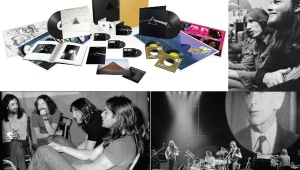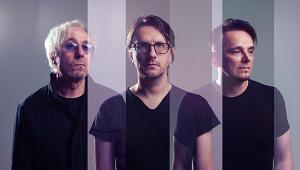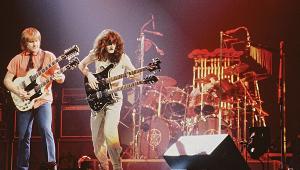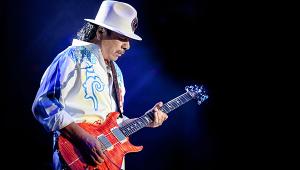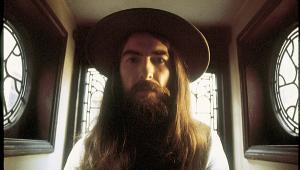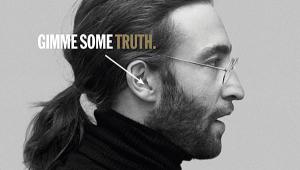Recording and Remixing Revolver Page 2
Now, people often credit Emerick as some sort of engineering magician who came in on Day 1 full of ideas that propelled The Beatles into the future. And though Norman Smith had taught him that “it doesn’t happen in the control room,” working with The Beatles was different. “When we started doing Revolver, it was more demanding,” Emerick noted. “They’d say, ‘Well, we don’t want that sound. We’re gonna do a guitar and we’re gonna do a piano but we don’t want it sound like a piano or a guitar. Can’t we make it sound different?’ And I had nothing. What could I do? I’d just conjure up these things in my head and try to experiment.”
Says Bill Smith, “He knew how to operate the equipment and he understood what the knobs and dials did from working with Norman all those years. But in terms of doing what they were asking him to do, he didn’t have a clue. It was just, ‘Well, let’s turn the knob all the way up and see what happens.’” And the band was as curious as he was, Giles Martin notes. “They were like kids, just going, ‘What does this do? What does that do? How can we make it sound like that?’ And Geoff and my dad were completely open to it all,” allowing them to bring what The Beatles were hearing in their heads to tape. The willingness to try and to bend the rules from what had come before was the genius of Geoff Emerick.
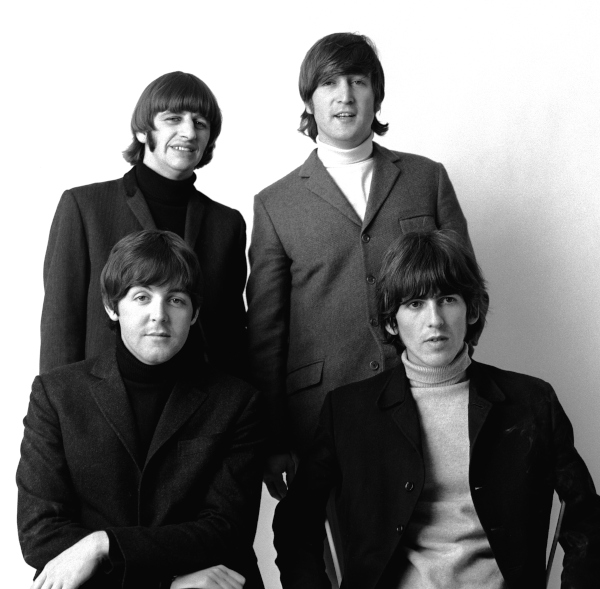
There was indeed a notable shift in the sound of The Beatles’ recordings, between Smith and Emerick. “Norman’s style was, in a sense, ‘polite,’ if you will,” Smith says. “Everything is nice and clean, no distortion. You don’t hear a lot of bottom on the bass and the vocals are way up there. You have a nice gentle George Harrison 12-string guitar on ‘If I Needed Someone’ from Rubber Soul — it’s clean, jangly, and sparkly. But here, there’s distortion — an aggression, which also drives how they’re writing, too. The whole thing changed once Geoff came along. The density of the record and the production.”
When thinking about Norman Smith, though, Kevin Howlett points out, “You have to be careful not to think that he was conventional and Geoff Emerick was the great revolutionary spirit. Because Norman did experimental things, as well.” Kehew concurs: “Remember, Norman jumped right in and did the first Pink Floyd album, which is was a much further ‘out there’ record than Sgt. Pepper, made the same year. He was not a stick-in-the-mud old dude. He was actually way cooler than almost all the other Abbey Road engineers.”
For the most part, Emerick stuck with Smith’s miking methodology, recording Ringo’s drums with an AKG D20 mic on the kick drum, a single STC 4038 overhead, and an AKG D19 on the hi-hat. (Changes to drum miking would come later in the year for the Sgt. Pepper sessions, according to Kehew, who, with Ryan, studied studio photos from both albums’ sessions to see what changes took place and when). As detailed in a memo to staff around this time, The Beatles were permitted, though, to have their engineer — Emerick or anyone else — to continue placing the expensive D20 mic as close as it had always been positioned to the kick drum. Engineers working with other acts were prohibited from doing so, due to the risk of damage to the D20’s diaphragm, forcing them to use cheaper microphones.
He did, however, change the room setup, which had a big effect on the sound of each instrument. “The normal setup in Studio 2 would have been to have the rhythm section on the carpeted end and the strings on the hard floor,” Emerick recalled. “I changed it all around and put the rhythm section on the hard floor, which gave it much more live sound.” And, in following the basic practice at EMI for pop recordings, the drums were moved from the far left corner where Smith had had them for years to more in the center of the left wall in the smaller Studio 3 (where most of Revolver was recorded), surrounded by gobos (padded partitions). “They’re damped down, in a smaller space,” says Bill Smith. “And now, suddenly, they have a lot more bottom end.” The guitar amps were placed in front of him, facing into the room and miked with Neumann U47s. Paul’s bass amp was to Ringo’s right, also separated by gobos, near where Paul can be seen standing in many studio photos.
Emerick was not the only EMI employee changing things. The brilliant technical engineer, Ken Townsend, was tasked with translating ideas from The Beatles, Emerick, and George Martin into technical reality. Having started on precisely the same day in 1950 that Martin joined EMI, Howlett notes, “Townsend was actually ‘recording engineer’” as opposed to a “balance and control” or simply “balance engineer.” Prior to the arrival of multitrack tape machines, he explains, “A recording engineer would set up the studio and stay for part of the sessions to make sure everything was all right, and then go away. But with multitrack, he would set up the studio and stay for the session. Ken was there.”
One of the most important systems Townsend developed addressed a specific challenge for The Beatles and other artists — double-tracking the lead vocal. “When you want to make a vocal sound thicker,” Kehew explains, “one of the ways to do that is to sing it twice. So if John wanted to make his voice sound cooler and thicker, he would often sing the part twice, and the two vocals would lay on top of each other. But it’s hard to do – you have to sing it precisely the same way. You can’t stretch one note too long, or one note too short. So it sometimes took them hours to get the second vocal right.”
Toward the end of the Rubber Soul sessions, Townsend heard Lennon complaining about the task and saying, “Can’t we get a machine to do it?” So Townsend began thinking about how to create a system that could indeed achieve double-tracking, automatically.
Townsend had worked previously at EMI’s Hayes manufacturing plant, which not only pressed records, but housed the company’s electronics division, which built equipment for the studios, including some of the tape machines used at their Abbey Road studio. He had the idea of drawing the vocal track signal from the sync head on the main 4-track tape machine and sending it to a mono tape machine where it could be recorded onto tape and sent back to the mixing console and combined with the previously-recorded vocal track. It worked.
But Townsend’s real genius was in how he perfected the process using one of the studio’s bulky Varispeed controls (which he had also built), which allowed him to adjust playback speed to be either slightly faster or slower than normal to create the effect of two vocals when the second vocal was added on top of the original. “It’s only slightly delayed, so it doesn’t sound like an echo,” Kehew explains, “It’s more like a slight smear. And when it comes back to the console as an effects return, it can be panned in stereo — so the original vocal could be heard on the left and the doubled vocal on the right.” As George Martin once noted, the two vocal signals “sounded like twins, not clones.”

As Howlett explains in the Deluxe Edition’s book, Townsend and engineer Stuart Eltham tested the system on a then-recent Cilla Black multitrack recording, to confirm that the system worked. It did. Eltham told Townsend he should name the system and, thus, the “Artificial Double Tracking” (ADT) system was born.
Sam Okell notes that even with this new invention at their disposal, The Beatles still chose to record second vocal tracks on plenty of songs on Revolver, including “Taxman” and “I’m Only Sleeping.” The ADT system was first put to work on the “Paperback write-write-write. . . ” tape-delay effect on “Paperback Writer” but wasn’t used for doubling vocals until a few days later on the mix of “Rain.” Okell also notes that though the speed of the delay could be adjusted during a mix for more or less spread, the setting remained static throughout the album.
Interestingly, it is not known at what point during the recording of a song either the group or Martin would decide whether a vocal would need to be doubled and, if so, whether it would be done using ADT in place of recording a second live vocal. “It’s the start of them going, ‘Okay, here’s an effect we’re gonna use more of, when we can’t be bothered to actually double the vocal,’” Okell observes. “It simply became part of their recording arsenal — “Can we ADT that?” Indeed, its use would advance a step further during the Sgt. Pepper sessions, with tape operator Richard Lush being called upon to vary the speed slightly during a mix to produce a “flanging” effect, as can be heard on “Lucy in the Sky with Diamonds.” But, for the moment, automatically doubling a vocal was plenty great.
Another important piece of equipment, which Emerick made ample use of in helping to develop The Beatles’ sound, was the Fairchild 660 compressor/limiter. While the device had been around the studio for a few years prior to this, with Smith using it on drums, Emerick had used it to great effect on the 1966 Manfred Mann hit, “Pretty Flamingo,” according to Kehew. “I put a dobro guitar through it, and got what for those days was a brilliant, bright sound,” he recalled. “It leapt out of the speakers.”
The goal of a compressor is to limit dynamic range, making loud things quieter and quiet things louder. “It fit right in with their ‘How do we make things sound bigger?’ goal,” says Bill Smith. “It evens out the volume, and makes the music jump out of the speakers. There’s more bottom end, more bass, and more kick drum. There’s a consistency of volume and a consistency of tone.” Adds Kehew, “Geoff continued using it on drums [as Norman Smith had], and then on everything — and that’s when it gets to be more of a known Beatles sound rather than just a nice sound on a piano or a vocal.”
Revolver: Track by Track
Revolver was recorded, for the most part, in EMI Studio 3 at Abbey Road, beginning April 6, 1966, and ending on June 22, after which the band immediately left for a brief German tour. Recording was not continuous during that period, often with several days between sessions to allow time for writing and other activities.
It was at this point in time that The Beatles began having a lot more input into the creation of their recordings, working alongside George Martin instead of fully depending on him to come up with sounds for their songs as they had done on earlier albums. “There were so many things that put The Beatles on a genius level, compared to other bands,” Howlett states. “They, of course, had brilliant songs to start with, and then this uncanny knack for arranging songs. George Martin was still a great sounding board for them. He’d certainly help them with harmony arrangements, but, pretty early on, The Beatles had in their heads this great way of arranging.”
One of the things that makes Revolver so special is how across its 14 songs it presents so many distinct styles — from the raucous “She Said She Said” to the poignant “Eleanor Rigby.” “I spoke to Paul about it,” says Giles Martin, “and he said, ‘Yeah, Revolver was us becoming individuals.’ They were remarkable, in the way they surfed this wave of creativity, especially during this period of time.” And, as can be heard on the outtakes on the “Sessions” discs — Paul’s count-in to the basic track for “Paperback Writer” is but one example — there was an incredible excitement. “You can hear it — they just can’t wait to record. With Revolver, you find four guys unwrapping their presents.”
To complement the excellent track notes Kevin Howlett presents for each of the album’s 16 songs in the book that accompanies the new Super Deluxe edition of Revolver, here are some additional interesting details.
Tomorrow Never Knows
When Emerick arrived in the Studio 3 control room on Wednesday, April 6, he encountered two surprises. “I thought George Martin would have informed all The Beatles that Norman wasn’t going to [be their engineer] anymore,” he recalled. “I hadn’t slept all night — I was obviously very nervous, ’cause this is the first Beatles session. I heard George saying [over an open mic], ‘Well, where’s Norman?’ And then George Martin said, ‘Well, Norman’s not doing it anymore.’ And I thought, ‘Oh, my God — George hasn’t told them!’”
Emerick rapidly won points, though, thanks to the role he played with the second surprise: the group was starting with John’s surreal, psychedelic “Tomorrow Never Knows.” “George Martin had made certain Emerick was aware of the great responsibility he was taking on before he was thrown in at the deep end,” Howlett observes. “And what a baptism of fire — to do ‘Tomorrow Never Knows’ first.”
The recording, as described in Howlett’s track notes, was based on a basic rhythm with just drums and bass, while John sang his vocal live. (The initial Take 1 pass, which was discarded, featured a two-bar loop with bass, drums, and two guitars onto which Ringo tracked a second drum track.) “It’s really what, today, we would call a trance/drone piece, roughly based on one chord,” Kehew says. “It’s repetitive, it’s loopy. They were that far ahead of the game — very bold and very much ahead of where anybody in popular music was going.”
One of the key textures of the recording was provided by tape loops each band member made at home on Brenell Engineering MK5 stereo tape recorders. The loops could be cut up and played in cycles at any speed. As Howlett describes, the band had amassed a large collection of these recordings, which were ultimately whittled down to a set of five, the most notable of which was Paul saying, “Ah, ah, ah, ah,” which when sped up, created the creepy screeching seagull sound heard through the song. Among the other selections was a chord from an orchestral record, a “Varispeeded” recording of a Mellotron’s “flute” setting, a sitar bit played backwards, and a Mellotron’s “strings” setting.
As was the case with all of their recording research, Howlett and Heatley had access to the original multitrack recordings, all of which have been transferred to Pro Tools by Abbey Road veteran Matthew Cocker. Cocker goes through each and every reel with the two researchers, allowing them to solo/isolate individual tracks, slow down recordings, or hear things in reverse, as needed (in this case, enabling them to study the tape loop recordings quite specifically). “Solo-ing tracks, for instance,” says Howlett, “allows us to determine if a part on one track was recorded as an overdub or was recorded live with the rhythm track.” If, for example, a guitar part by George on Track 2 of a recording is heard while listening to the soloed rhythm track on Track 1, picked up by one of the other microphones, then the part was indeed played live during tracking. “And if it’s clean, you know it’s an overdub.”
On this song, the five loops were set up on BTR2 mono machines around the building, and fed to the control room in Studio 3, each coming up on its own fader. George Martin told the story many times over the years that the effects were mixed live during the recording’s final mix, which would prevent it from ever being remixed. But that was not the case. As Giles discovered in 2005, while creating the soundtrack to the LOVE show, the loop track was actually recorded to Track 2 of the 4-track tape on April 7, in what appears to be a wonderful, carefully-orchestrated recording.
“They would have had all five loops up and running, and then mixed them live on the console, fading up one sound on one fader, and then a different one in a different point in the song,” says Okell, who notes there is never one loop playing atop another. He also notes the presence of two unused sounds — a backwards guitar, which appears on the tape before the first heard effect, and a bit of organ. “It was not a continuous mix — it does start and stop. They would find sections they wanted to work a few bits into, and then move on to another section. It’s quite intentionally shaped on the tape.” Adds Martin, “They probably spent quite a lot of time getting it right, saying, ‘Okay, which bit do we want here?’” The result is a very strange and very creative instrument of loops, which brilliantly gives the song an eerie, psychedelic experience with which to close the album.
John, as has often been told, wanted his voice to sound like “the Dalai Lama singing from a hilltop.” That was the assignment to his producer and engineer. But how does one take that instruction and create that sound? The effect was created by feeding his vocals through a rotating Leslie speaker, and then recording that speaker. Says Kehew, “These are the tools that the engineers and technical people knew. For John, it was, ‘How can we mess up my voice? I don’t want to sound like me. Can we put an echo on my voice? Can we put it through a filter? Can we do it backwards?’ Lennon, especially, was interested in changing his vocal persona into something fresh, and different than ‘the boring old me.’ This was the beginning of them doing that, which would become really strong on Sgt. Pepper.”

